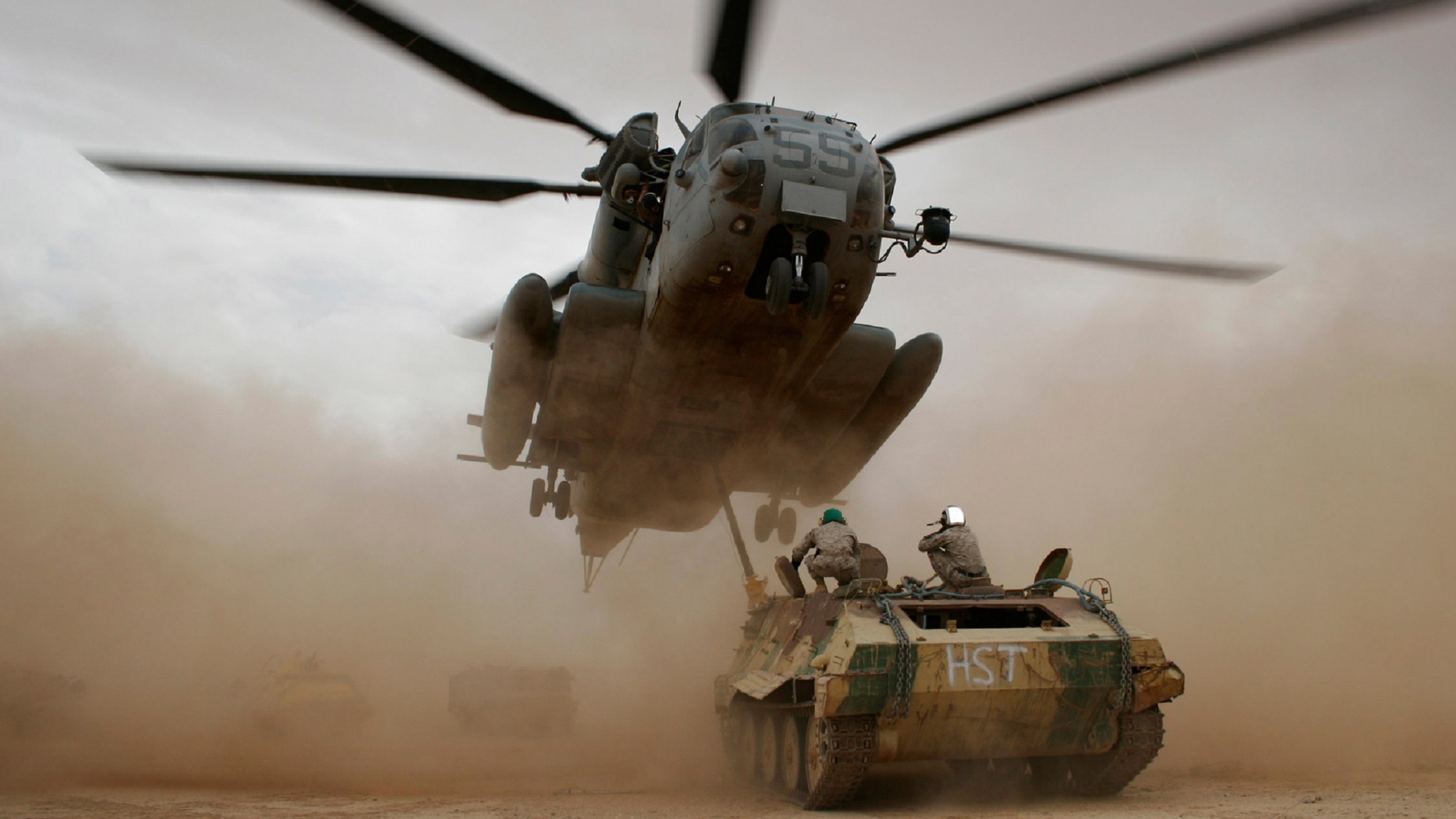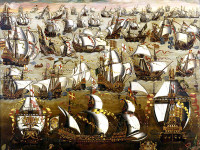England was under Queen Maria I a country that was ruled by a Catholic. Their marriage to the Spanish King Philip II was to build a close connection between the two countries. However, after the death of Mary in 1558, her Protestant half-sister Elizabeth I followed not only to diplomatic tensions, but after alliances with Catholic or Protestant movements to an open war between the countries.
Unofficially, England had been conducting a trade war against Spain since the mid-16th century under the blessing of Queen Elizabeth I. For example, captain Francis Drake was issued a hijacking letter that enabled him to attack and plunder Spanish ships carrying gold and silver from the South American colonies to Spain. Other captains such as Martin Frobisher or John Hawkins acted with such a badge equipped against Spanish ships.
When it came to the Protestant uprisings in the Netherlands, England initially had only secret financial support. Only little by little did Elisabth admit to the resistance and support it officially, much to the annoyance of the Catholic King of Spain. Thus, in 1585, the English sent an expeditionary army to the Netherlands under the leadership of the Earl of Leicester. Although this did not lead to a military turn in the conflict, the open hostilities between England and Spain are intensifying.
So Francis Drake intensified his attacks in the Caribbean. Together with Martin Frobisher he attacked Santo Domingo in January 1586, Cartagena de las Indias a few weeks later. After rumors reached Drake that Spain would equip a large naval fleet against England, he decided to proceed directly against Spain and attacked in 1587 the city of Cádiz, which lies in the south of Spain. He plundered warehouses and sank dozend Spanish ships, which delayed the deployment of the Armada for some time.
In 1588, the armada with 24 warships, 47 armed merchant ships and transport ships with about 20,000 soldiers with a delay but still be set up and set sail in the English Channel. Coming from Flanders, on smaller ships about 30,000 additional soldiers under the command of Duke of Parma should unite with the Armada and carry out an invasion of England. On the way, however, the fleet of Parma was stopped by the Dutch Watergeuzen, so that the armada remained in Calais. Through the unprotected anchorage, the English took the opportunity and drove Brander (set fire to ships) on the armada. In panic, the captains cut off the ropes of the ships, breaking the line of defense. Under Lord Howard of Effingham, the British ships opened the fire and were able to sink 4 Spanish ships and severely damage some others. The planned invasion of England could thus be thwarted and the armada displaced into the North Sea. On the journey home, it came to disaster when about 60 ships and thousands of soldiers were lost in the stormy waters.
In the following years, the English tried again and again in the Azores to intercept the silver supplies to Spain, which rarely succeeded. Despite this, the war brought Spain to the verge of bankruptcy. In return, Spain, through the support of Hugh O'Neill, the Earl of Tyrone, sought to advance the uprising against the British in Ireland. So in 1601 Spanish soldiers landed on the coast of Cork, but were encircled by the English and had to surrender in Kinsale.
1598 died the Spanish king Philip II and his son and successor Philip III. The first negotiations led to a peace, which was however first broken off by the excessive demands of the Englishmen. After the death of Queen Elizabeth I in 1603, James I ascended the English throne. He also tried to end the war and issued antipiracy laws in the same year. From May to August 1604, peace talks were held at Somerset House on the Strand in London. On August 28, 1604, the contract was then signed. Among other things, it included the return of plundered goods with a compensation payment, the waiver of the Spaniards in support of the Counter-Reformation in England as well as the termination of the British support in the rebellion in the Netherlands.

Signature of the Peace Treaty 1604. On the English side: Thomas Sackville, Charles Howard, Charles Blount, Henry Howard and Robert Cecil; on the Spanish side: Juan de Velasco, Juan de Tassis, Alessandro Robido, Charles de Ligne, Jean Richardot and Louis Verekyn.
You can find the right literature here:
The Cousins' Wars: Religion, Politics, Civil Warfare, And The Triumph Of Anglo-America

The Cousins' Wars: Religion, Politics, Civil Warfare, And The Triumph Of Anglo-America Paperback – 1999
The question at the heart of The Cousins' Wars is this: How did Anglo-America evolve over a mere three hundred years from a small Tudor kingdom into a global community with such a hegemonic grip on the world today, while no other European power—Spain, France, Germany, or Russia—did? The answer to this, according to Phillips, lies in a close examination of three internecine English-speaking civil wars—the English Civil War, the American Revolution, and the American Civil War. These wars between cousins functioned as crucial anvils on which various religious, ethnic, and political alliances were hammered out between the English-speaking cousin-nations, setting them on a unique two-track path toward world leadership—one aristocratic and aloof to dominate the imperial nineteenth century and the other more egalitarian and democratic to take over in the twentieth century. They also functioned as unfortunate and deadly cultural crucibles for African Americans, Native Americans, and the Irish.Phillips's analysis shows exactly how these conflicts are inextricably linked and how they seeded each other. He offers often surprising interpretations that cut across the political spectrum—for instance, that the Constitution of the United States, while brilliant in many respects, was also a fatally flawed political compromise that contributed mightily in setting the stage for the final—and the bloodiest—cousins' war: the American Civil War.With the new millennium upon us and triggering widespread assessment of our nation's place in world history, The Cousins' Wars provides just the kind of magisterial sweep and revisionist spark to ignite widespread interest and debate. This grand religious, military, and political epic is the multi-dimensional story of the triumph of Anglo-America.
The Last Armada

The Last Armada: Queen Elizabeth, Juan del Águila, and Hugh O'Neill: The Story of the 100-Day Spanish Invasion 1st Edition
As thunder crashes and lightning rakes the sky, three very different commanders line up for a battle that will decide the fate of a nation. General Juan del Águila has been sprung from a prison cell to command the last great Spanish armada. His mission: to seize a bridgehead in Queen Elizabeth's England and hold it.
Facing him is Charles Blount, a brilliant English strategist whose career is also under a cloud. His affair with a married woman edged him into a treasonous conspiracy―and brought him to within a hair’s breadth of the gallows.
Meanwhile, Irish insurgent Hugh O’Neill knows that this is his final chance to drive the English out of Ireland. For each man, this is the last throw of the dice. Tomorrow they will be either heroes or failures.
These colorful commanders come alive in this true story of courage and endurance, of bitterness and betrayal, and of drama and intrigue at the highest levels in the courts of England and Spain.
The English Armada: The Greatest Naval Disaster in English History
During the year between July 1588, when the Spanish Armada set sail from Spain and July 1589, when the survivors of the English counterpart of this fleet, the little-known English Armada, reached port in England, two of history's worst naval catastrophes took place. A great deal of attention has been dedicated to the former and precious little to the latter. This book presents a full-scale account of an event which has been neglected for more than four centuries.
It reconstructs the military operations day by day for the first time, taking apart the established notion that, with the defeat of the Spanish Armada, England achieved maritime supremacy and the decay of Spain began. This book clearly and in a rigorously documented fashion shows how the defeat of the English Armada counterbalanced that of the Spanish, frustrating England's intention of seizing Philip II's American empire and changing the tide of the war.
Britannia's Glories

Britannia's Glories: The Walpole Ministry and the 1739 War with Spain (Royal Historical Society Studies in History New Series) First Edition Edition
This first full-length study of the 1739 war with Spain, the so-called `War of Jenkins' Ear', looks at both the Spanish and the British side of disputes arising from illicit British trading in the Spanish ports of the Caribbean and the sometimes brutal depredations committed by the Spanish ships licensed to suppress it. It considers the domestic contexts in both countries, including the pressures which bore upon unpopular monarchs and their ministers; in particular, the author demonstrates the vigour with which opposition newspapers vaunted the heritage of British naval power: if ministers only had the political will, it was supposed, Britannia's glories would be revived and she would humble the cowardly popish foreigners of Spain and France. In examining foreign policy in the closing years of the long-lived Walpole ministry, light is also shed on the inner workings of `high politics', and new evidence offered on the development of the cabinet and the important role played by George II. The author concludes that the breakdown of complex and delicate Anglo-Spanish negotiations over the American trade was due not just to British popular outcry over Jenkins' ear but had a variety of causes, including entrenched national principles, and the interplay of individual personalities.Dr PHILIP WOODFINE teaches in the Department of Humanities at the University of Huddersfield.
This post is also available in:
 Deutsch (German)
Deutsch (German)  Français (French)
Français (French)  Italiano (Italian)
Italiano (Italian)  简体中文 (Chinese (Simplified))
简体中文 (Chinese (Simplified))  Русский (Russian)
Русский (Russian)  Español (Spanish)
Español (Spanish)  العربية (Arabic)
العربية (Arabic)















